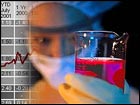|
Investing in bioterror
|
 |
October 19, 2001: 7:04 p.m. ET
Among a number of hyped-up stocks, a few biotechs may make sense.
By Lisa Gibbs
|
NEW YORK (CNNmoney) - Rising fears of an anthrax epidemic have sent so-called bioterrorism stocks soaring since Sept. 10. Shares of Cepheid, a firm that uses DNA technology to ferret out biological infections like anthrax, have skyrocketed more than 200 percent since before the attacks. Another (until recently) obscure company that's received a government order for its chemical-detection alarms, American Access Technologies, is up 170 percent.
If you're feeling tempted to buy some of these stocks now, resist. These stocks' teeny size and lack of earnings make them a risky bet in normal times, and experienced biotech investors warn that the recent run-up is way overdone.
"This is an emotional reaction," said James Jundt, whose money management firm has owned Sunnyvale, Calif.-based Cepheid (CPHD: down $0.73 to $4.70, Research, Estimates) on and off since its initial public offering in early 2000. "Unless you think we're going to live under continuous siege for a decade, most of these are better shorts than they are purchases."
Already many of these stocks have pulled back from their post-attack highs; those who bought Cepheid at its Oct. 10 high of $11.48 have lost more than half their money. American Access (AATK: down $0.04 to $1.85, Research, Estimates) is down 65 percent since then. Another bioterror crash-and-burn story is Avant Immunotherapeutics (AVAN: down $0.17 to $3.44, Research, Estimates), down 50 percent from its high.
A smarter way to play
James Fiore, who runs biotech hedge fund Life Sciences Group, says he thinks investors plowing into bioterrorism stocks are chasing the wrong trend. The real opportunity, he argues, lies in companies that are developing new forms of antibiotics to fight drug-resistant bacteria.
Fear of anthrax has Americans rushing to their doctors for prescriptions of Bayer AG's antibiotic ciprofloxacin, or Cipro. But the Cipro scramble has intensified physicians' concerns that the overuse of germ-killing antibiotics spawns bacteria resistant to treatment, an existing problem that's exacerbated when people take drugs that aren't really necessary.
"The real problem we face is antibiotic resistance," Fiore said. "The companies working to fight that problem - those are the real investments."
His favorite: Cubist Pharmaceuticals (CBST: up $1.39 to $40.65, Research, Estimates), which has finished the Phase III clinical trial of its new antibiotic daptomycin and is expected to present results at the Infectious Disease Society of America's 39th annual meeting later this month. If approved, Fiore said, daptomycin will be one of the first new classes of antibiotics developed in 20 years. The company also holds the worldwide rights to an oral ceftriaxone, a version of a new intravenous antibiotic called Rocephin.
"Fifteen, 20 years ago, the pharmaceutical companies said, 'OK, bacteria are licked so we're not going to develop any more antibiotics,' except nobody told the bacteria about that," Fiore said.
Like most young biotech companies, Cubist loses money: $34.4 million for the first six months of this year on $5.7 million of revenue. Fiore cautions that investors should only consider buying if they are willing to accept a hefty dose of risk.
Fiore also likes ArQule Technologies (ARQL: down $0.79 to $11.28, Research, Estimates), a Woburn, Mass.-based firm that creates the chemistry used to develop drugs. It's a safer buy than Cubist, says Fiore, because ArQule has more stable revenues from contracts with large drugmakers like Pfizer to sell its chemistry.
Lastly, Fiore says that if investors are determined to make an anthrax bet, Nanogen (NGEN: down $0.41 to $7.28, Research, Estimates) is the most promising of the bunch. The company markets miniaturized devices to scientists and genomics laboratories for the analysis of DNA, which can be used to isolate and detect infectious disease bugs from blood samples. The Federal Bureau of Investigation uses Nanogen's products, and Fiore believes that ease of use will make Nanogen popular with other police labs as well.
Revenue as of June 30 totaled $5.7 million; losses amounted to $18 million. At $7.28, Nanogen is up 54 percent from Sept. 10, but 28 percent off its post-attack high. 
|
|
|
|
|
 |

|

